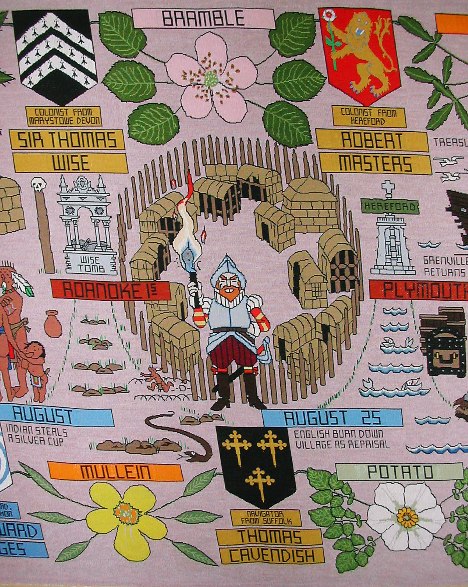|
Back to 1585 Menu

Grenville’s
reaction to the non-return of the stolen silver cup is predictably swift. The boot goes in. On 25 August he gives orders to
his men to burn down the village as a reprisal and here is shown that command about to be carried out. Note the Indian running
for his life.
The picture of the village is based on another of John White’s drawings.
Not surprisingly the Indians
do not take too kindly to Grenville’s action but do not retaliate at once. Though incensed, and vowing vengeance on
the white intruders they sensibly stay their hands for the time being for they cannot match the vastly superior weaponry that
the settlers possess, especially the cannon in the fort.
Friends Thomas Cavendish and Robert Masters are both named in this
scene and the shields at their coats-of-arms shown. Neither are in the expedition as colonists but involved as navigators
in the ship Elizabeth. Cavendish comes from Frimley St Martin in Suffolk; Masters from Hereford.
In 1588
Cavendish will fit out an expedition on his own account to exploit the South Seas and circumnavigate the globe. Masters will
go with him and they will follow the same course that Drake had used nine years before. However they will encounter many hazards
and Cavendish with two of his ships will be lost. Fortunately Masters will survive aboard the third vessel and return a few
months after the defeat of the Spanish Armada, heavily laden with treasure won from the Spanish.
Masters’ share
of the booty will make him wealthy enough to settle down to live a life of ease as Lord of the Manor of
Burghill, Hereford. Here, in Burghill Church, in later years, his voyages with Cavendish to Virginia and round the world will be recorded on a brass which can still be
seen today. The Tapestry’s tribute to him is to show, on the right of this scene, the Market Cross at Hereford.
|
 |
|
|
|
 |
|

BRAMBLE Rubus. ‘ They heale the eyes that hang
out, hard knots in the fundament, and stay the hemorrhoids’. Gerard. POTATO Battata Virginiana, fine Virginianorum & Pappas ‘These roots were forbidden in Bourgondy for that they were persuaded the
too frequent use of them caused the leprosie’. Bauchine.
|
 |
|
|
|

